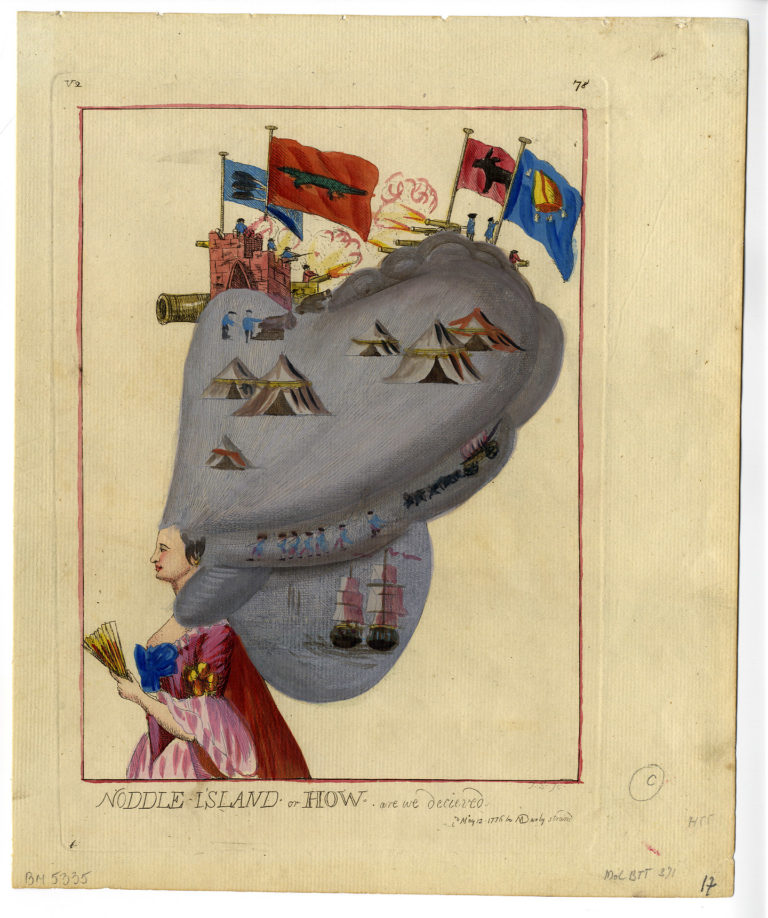Introduction to The History of a French Louse


In 1779, a satire called The History of a French Louse; or, the Spy of a New Species, in France and England was published in London. On its title page, the book claims to be a fourth edition translated from the French. A French edition was also published in 1779, but there is no evidence that previous editions exist.
The Louse was published anonymously but is often attributed to “Delauney.” The text is an “it narrative,” part of a genre of tales told by nonhuman narrators that was wildly popular in Britain and the Anglo-Atlantic world in the late eighteenth century. The satire’s narrator is a louse who has lived on a series of heads in and around Paris and been witness to the political maneuverings happening behind the scenes of the American Revolution.
This anti-revolutionary satire, the centerpiece of which is a caricature of Benjamin Franklin, quickly made its way to British colonial North America. In 1781, advertisements for the Louse appeared in the Loyalist newspaper the Royal American Gazette, which was published in New York City. In Philadelphia, the Louse circulated at least until the 1830s. The Library Company of Philadelphia holds two copies of the text, one of which was damaged in a fire in 1831. Readers cared enough about the Louse to rebind it afterward with a group of pamphlets that had been similarly damaged.
Upon its publication, the Louse joined a wave of anti-Franklin propaganda unfolding on both sides of the Atlantic. Satirical renderings of Franklin as a self-serving lush and lecher were popular in France, England, and British America. From its position on the scalp of a dinner guest, the Louse’s narrator introduces Franklin as “a man of great note who came from another part of the world,” as a minister representing a people who’d recently rebelled (19). Franklin is then quickly derided as a “grotesque figure,” sunburnt, wrinkled, and warty with absurd spectacles. The louse also encounters Marie Antoinette; Mademoiselle d’Éon, who had been a diplomat and spy under the male identity Chevalier d’Éon but later identified as female; and Pierre Beaumarchais, a French supporter of the American rebellion.
In addition to skewering some of the most famous people of the period, the Louse raises questions about the status of the individual agent and the scale of political action. Spying, after all, is so easy, and human bodies are not as individual and discrete as they might at first appear. Influential political philosophers of the period, including John Locke, acknowledged and sought to manage the material discontinuity of the human body—what Locke calls the “constantly fleeting particles of matter” that make up a man. The louse inhabits bodies that ooze both matter and information, which he carries with him as he scurries from head to head.
By the late eighteenth century, the idea of a social parasite and the idea of a biological parasite would both have been familiar to readers. The Louse makes the predictable anti-revolutionary argument that British colonial Americans like Franklin are lousy parasites. It also explores the uneasy possibility that some minute part might scramble off a human body and go on to tell a story of its own, with significant political consequences.
The History of a French Louse is available on GoogleBooks. Google unfortunately omits four prefatory pages, in which the louse introduces himself as the first author of his species, dedicates his narrative to King Louis XVI, laments his misfortunes, and declares himself as stoic as a Roman republican statesman. This introductory material is digitized in the Sabin Americana Digital Archive. You can also find copies of the Louse at the Library Company of Philadelphia, the Huntington Library, or the Newberry. An excerpt from the text appears in British It-Narratives 1750-1830, Volume 2: Animals.
Further Reading
For more on Loyalist writing in British colonial America, see Philip Gould, Writing the Rebellion: Loyalists and the Literature of Politics in British America (New York, 2013). On Franklin in France, see for example Stacy Schiff, A Great Improvisation: Franklin, France, and the Birth of America (New York, 2005). For more on it narratives, see Lynn Festa, Sentimental Figures of Empire in Eighteenth-Century Britain and France (Baltimore, 2006); Mark Blackwell, ed., The Secret Life of Things: Animals, Objects, and It-Narratives in Eighteenth-Century England (Cranbury, N.J., 2007); and Jonathan Lamb, The Things Things Say (Princeton and Oxford, 2011). For an argument about social relations as fundamentally parasitic, see Michel Serres, The Parasite, trans. Lawrence R. Schehr (Minneapolis, 2007). The excerpt of the Louse is in British It-Narratives, ed. Heather Keenleyside (London and Brookfield, Vt., 2012).
This article originally appeared in issue 17.3 (Spring, 2017).
Julia Dauer is a PhD candidate in the department of English at the University of Wisconsin-Madison, where she studies eighteenth- and nineteenth-century American literature and the history of science.

